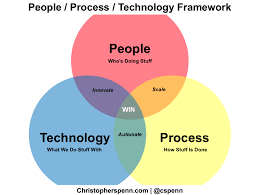The Evolution of Process Technology
Process technology, also known as process engineering, plays a crucial role in various industries, from manufacturing to chemical processing. It involves the design, operation, control, and optimization of processes used to produce goods and services.
Over the years, process technology has evolved significantly, driven by advancements in automation, digitalization, and sustainability. One of the key goals of modern process technology is to improve efficiency, reduce waste, and enhance product quality.
Key Components of Process Technology:
- Process Design: This stage involves conceptualizing and planning the overall process flow, including equipment selection and layout.
- Process Control: Utilizing sensors, actuators, and control systems to monitor and adjust process variables in real-time for optimal performance.
- Process Optimization: Analyzing data to identify bottlenecks, inefficiencies, and opportunities for improvement in the process.
- Safety Protocols: Implementing measures to ensure the safety of personnel and prevent accidents during the operation of the process.
The Impact of Digitalization on Process Technology:
In recent years, digital technologies such as Internet of Things (IoT), artificial intelligence (AI), and big data analytics have revolutionized process technology. These technologies enable real-time monitoring, predictive maintenance, and data-driven decision-making.
By leveraging digital tools, companies can optimize their processes more effectively, reduce downtime, and improve overall operational efficiency. Additionally, digitalization allows for remote monitoring and control of processes, enhancing flexibility and scalability.
The Future of Process Technology:
Looking ahead, the future of process technology is likely to be shaped by further advancements in automation, robotics, machine learning, and sustainability practices. Companies will continue to focus on minimizing environmental impact while maximizing productivity.
As industries evolve and consumer demands change rapidly, process technology will play a vital role in enabling businesses to adapt quickly and stay competitive in a dynamic market landscape.
Six Essential Tips for Enhancing Your Process Technology Operations
- Ensure proper equipment maintenance for optimal performance.
- Regularly monitor and analyze process data to identify areas for improvement.
- Implement automation where possible to increase efficiency and reduce errors.
- Train employees on best practices to ensure safe and effective operation of the technology.
- Stay updated on industry advancements and trends to remain competitive.
- Collaborate with other departments to streamline processes and achieve overall business goals.
Ensure proper equipment maintenance for optimal performance.
Ensuring proper equipment maintenance is a crucial tip in process technology to achieve optimal performance. Regular maintenance routines help prevent unexpected breakdowns, reduce downtime, and extend the lifespan of equipment. By keeping machinery in top condition, processes can run smoothly and efficiently, leading to improved productivity and higher-quality output. Proper maintenance also contributes to a safer working environment and minimizes the risk of accidents or malfunctions. Investing time and resources in equipment upkeep is essential for maximizing operational efficiency and ensuring the long-term success of any process-driven operation.
Regularly monitor and analyze process data to identify areas for improvement.
Regularly monitoring and analyzing process data is a crucial tip in process technology to identify areas for improvement. By tracking key performance indicators and analyzing data trends, companies can pinpoint inefficiencies, bottlenecks, or deviations from optimal performance. This proactive approach enables process engineers to make informed decisions, implement targeted improvements, and optimize processes for enhanced efficiency and quality. Continuous monitoring and analysis of process data are essential for driving innovation, increasing productivity, and maintaining a competitive edge in today’s dynamic industrial landscape.
Implement automation where possible to increase efficiency and reduce errors.
Implementing automation in process technology is a strategic approach to boost efficiency and minimize errors. By automating repetitive tasks and utilizing technology to streamline processes, organizations can achieve higher productivity levels while reducing the risk of human error. Automation not only speeds up operations but also ensures consistency and accuracy, leading to improved overall performance and quality output. Embracing automation where feasible in process technology can bring about significant benefits in terms of cost savings, time management, and operational excellence.
Train employees on best practices to ensure safe and effective operation of the technology.
Training employees on best practices is essential to ensure the safe and effective operation of process technology. By providing comprehensive training programs, companies can empower their staff to understand the intricacies of the technology, adhere to safety protocols, and maximize operational efficiency. Well-trained employees are better equipped to identify potential risks, troubleshoot issues, and optimize processes for improved productivity. Investing in employee training not only enhances workplace safety but also contributes to a more skilled and knowledgeable workforce that can adapt to evolving technologies and industry standards.
Stay updated on industry advancements and trends to remain competitive.
Staying updated on industry advancements and trends is essential in the field of process technology to remain competitive. By keeping abreast of the latest developments, professionals can leverage new technologies, methodologies, and best practices to enhance efficiency, improve product quality, and streamline operations. Continuous learning and adaptation to industry changes not only ensure a competitive edge but also pave the way for innovation and sustainable growth in a rapidly evolving technological landscape.
Collaborate with other departments to streamline processes and achieve overall business goals.
Collaboration with other departments is a key tip in leveraging process technology to streamline operations and achieve overarching business objectives. By breaking down silos and fostering communication between different teams, organizations can identify bottlenecks, eliminate redundancies, and optimize workflows for greater efficiency. This cross-functional approach not only enhances coordination but also ensures that process improvements align with the broader strategic goals of the company. Through collaboration, departments can leverage their unique expertise to drive innovation, enhance productivity, and ultimately propel the organization towards success in a competitive market landscape.
Tags: actuators, artificial intelligence ai, automation, big data analytics, bottlenecks identification, chemical processing, control, control systems, data analysis, design, digitalization, efficiency, equipment selection, evolution, layout, manufacturing, operation, optimization, predictive maintenance, process control, process design, process optimization, process technology, product quality, real-time monitoring, safety protocols implementation, sensors, sustainability, waste reduction
